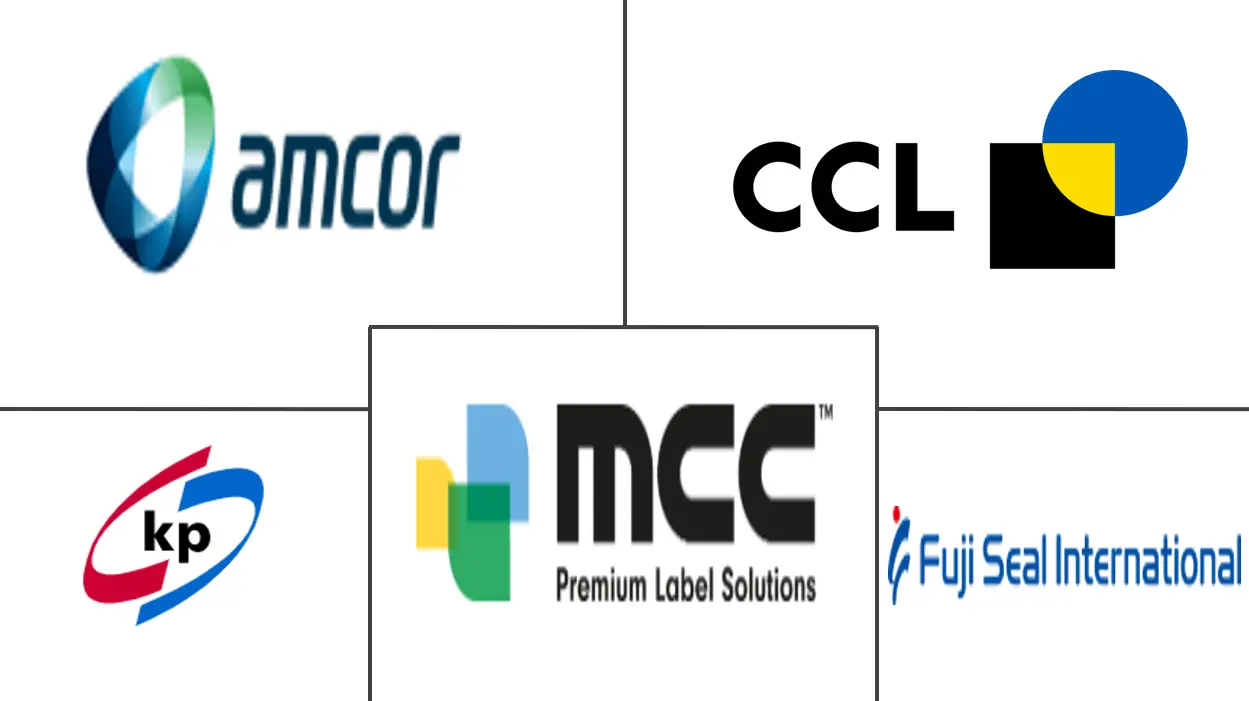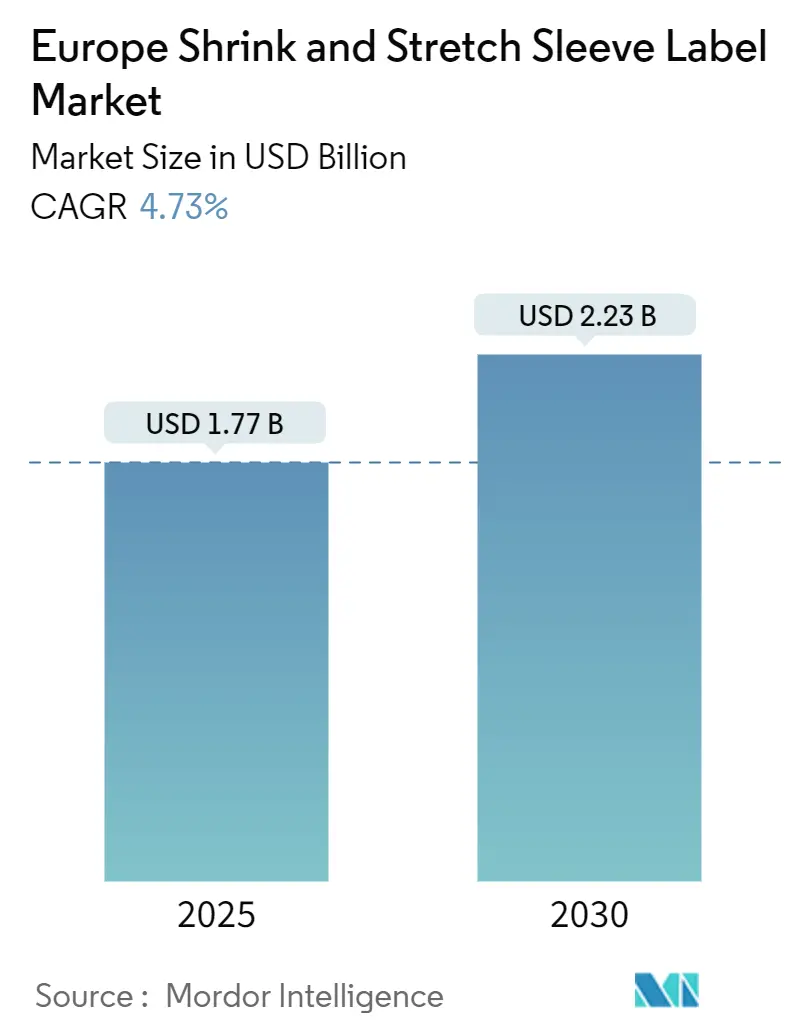
Europe Shrink And Stretch Sleeve Label Market Analysis by Mordor Intelligence
The Europe shrink and stretch sleeve label market size stands at USD 1.77 billion in 2025 and is projected to reach USD 2.23 billion by 2030, expanding at a 4.73% CAGR.[1]Publications Office of the European Union, “Regulation (EU) 2025/40 on packaging and packaging waste,” eur-lex.europa.eu Sustained demand from premium consumer goods, tightening recyclability rules, and rapid investments in polyolefin converting lines underpin this steady trajectory. Beverage brands are re-engineering sleeves to survive deposit-return schemes without sacrificing visual impact, while personal care players scale 360-degree graphics to justify premium shelf pricing. Material substitution toward polyethylene accelerates as converters seek substrates that pass EU sorting trials. Competitive intensity rises as petrochemical consolidation inflates resin costs, forcing mid-tier converters to choose between capacity upgrades and exit. Inline digital printing unlocks cost-effective short runs that help brand owners localize campaigns and reduce inventory risk.
Key Report Takeaways
- By type, heat shrink sleeves led with 68.71% of the Europe shrink and stretch sleeve label market share in 2024; stretch sleeves are forecast to expand at a 5.89% CAGR through 2030.
- By material, PET-G commanded 40.23% share of the Europe shrink and stretch sleeve label market size in 2024, while polyethylene is advancing at a 5.94% CAGR through 2030.
- By application, beverage accounted for a 45.89% share of the Europe shrink and stretch sleeve label market size in 2024; personal care is growing at a 5.78% CAGR through 2030.
- By geography, Germany held 25.67% of the Europe shrink and stretch sleeve label market share in 2024, whereas Poland is projected to record the highest 6.13% CAGR to 2030.
Europe Shrink And Stretch Sleeve Label Market Trends and Insights
Drivers Impact Analysis
| Driver | (~) % Impact on CAGR Forecast | Geographic Relevance | Impact Timeline |
|---|---|---|---|
| Demand to increase on-shelf appeal | +0.8% | Western Europe core, expanding to CEE | Medium term (2-4 years) |
| Need for tamper-evident protection | +0.6% | EU-wide, strongest in pharmaceutical hubs | Short term (≤ 2 years) |
| Shift toward 360° branding surfaces | +0.9% | Premium markets: Germany, France, Netherlands | Medium term (2-4 years) |
| Adoption of recyclable polyolefin shrink films | +1.2% | EU-wide compliance driven | Long term (≥ 4 years) |
| Inline digital printing integration | +0.7% | Manufacturing centers: Germany, Italy, Poland | Medium term (2-4 years) |
| Lithium-metal additive inks enabling ultra-thin sleeves | +0.4% | High-tech markets: Germany, Netherlands, Nordic | Long term (≥ 4 years) |
| Source: Mordor Intelligence | |||
Demand to Increase On-Shelf Appeal
Retail shelf space rationalization intensifies visual competition, prompting brand owners to adopt full-body sleeves that convert an ordinary container into a 360-degree billboard. Craft beverage lines exploit limited-edition graphics to boost unit margins, while mass-market soda brands rotate seasonal artwork without disrupting fill-line speeds. Western European consumers continue to reward premium aesthetics with repeat purchases, helping sleeves defend pricing versus pressure-sensitive labels. As retailers expand private-label ranges, national brands double down on differentiated decoration to avoid commoditization. The broader European packaging sector’s value climb from EUR 153 billion in 2024 to EUR 186 billion by 2029 signals headroom for upscale formats.
Need for Tamper-Evident Protection
EU pharmacovigilance rules mandate overt security features, making shrink sleeves attractive because removal leaves visible damage. Nutraceutical producers embed micro-text and color-shift inks to authenticate packages at point of sale. Counterfeit concern has risen sharply since 2024, pushing supermarkets to favor tamper-proof formats even for premium juices. Government inspectors also prefer sleeves that signal breach instantly during cold-chain audits. Growing e-commerce adds another touch-point where packages can be compromised, further raising demand.
Shift Toward 360° Branding Surfaces
Premium soap, hair-care, and cosmetics brands favor story-telling through wrap-around graphics that integrate mandatory multilingual text without clutter. Heat-shrink clarity enables photographic imagery over curved shoulders, while high-opacity white inks allow metallic effects on stretch sleeves. Digital presses now support spot-gloss and tactile coatings inline, letting pilot runs hit shelves in under two weeks. Germany and France lead adoption as luxury goods conglomerates retrofit plants for hybrid decoration lines. The approach also meets PPWR’s single-label guidelines, reducing mix-material SKUs.
Adoption of Recyclable Polyolefin Shrink Films
PPWR 2025/40 obliges all consumer packaging to be recyclable by 2030, steering converters away from PVC and multilayer PET-G toward mono-material polyethylene. Polyolefin sleeves float during sink-float separation, allowing PET bottles to recycle at food-grade quality. Investment momentum is visible in Italy and Spain, where three new blown-film lines started up in 2024. Raw-material suppliers partner with converters to certify sleeves under RecyClass protocols. As polyolefin demand rises, resin producers back-integrate into mechanical-recycling streams to secure feedstock.
Restraints Impact Analysis
| Restraint | (~) % Impact on CAGR Forecast | Geographic Relevance | Impact Timeline |
|---|---|---|---|
| Stricter EU plastics-packaging waste directives | -1.1% | EU-wide, strongest enforcement in Western Europe | Short term (≤ 2 years) |
| Rising prices of virgin PET-G and PVC resins | -0.9% | Manufacturing centers: Germany, Italy, France | Short term (≤ 2 years) |
| Limited recycling streams for multilayer films | -0.7% | EU-wide infrastructure constraints | Medium term (2-4 years) |
| Sleeve removal bottlenecks in EU deposit-return schemes | -0.6% | DRS markets: Germany, Netherlands, United Kingdom | Medium term (2-4 years) |
| Source: Mordor Intelligence | |||
Stricter EU Plastics-Packaging Waste Directives
PPWR introduces design-for-recycling checklists that invalidate many legacy sleeve constructions overnight. Converters must finance line trials, laboratory tests, and third-party certifications before 2027 while absorbing EPR fees that escalate annually. Brand owners use the legislation to renegotiate pricing, squeezing suppliers during investment peaks. Western European enforcement agencies already issued EUR 7 million in packaging fines during 2024, underscoring near-term compliance risk.[2]European Commission, “Proposal Packaging and Packaging Waste,” europa.eu Cash-strapped SMEs defer upgrades, risking market exit.
Limited Recycling Streams for Multilayer Films
EU collection systems favor mono-material streams; multilayer PET-G sleeves contaminate flake quality and incur reprocessing surcharges. Only eight mechanical recyclers in Europe accept mixed-structure labels at scale. Without critical mass, chemical-recycling ventures remain financially unviable. Converters scramble to qualify sleeves under RecyClass guidelines, delaying new product launches. Retailers threaten delisting unless suppliers provide recyclability evidence by 2026.
Segment Analysis
By Type: Heat Shrink Dominance Faces Stretch Innovation
Heat shrink sleeves represented 68.71% of the Europe shrink and stretch sleeve label market size in 2024 thanks to proven conformity around intricate bottle contours and integrated tamper-evidence on beverage lines. They remain the go-to choice for high-volume soda and water brands that run containers through steam tunnels at 50,000 bottles per hour. Yet regulatory and cost headwinds encourage brand owners to trial stretch sleeves, especially where container designs allow friction application without heat. The Europe shrink and stretch sleeve label market expects stretch formats to post a 5.89% CAGR through 2030 as removal ease becomes a compliance differentiator.
Converters hedging risk now operate dual-capability applicators, shifting between resin shrink ratios and stretch roll stocks to match customer specifications. The new equilibrium also benefits low-density polyethylene substrates that accommodate both technologies with minor oven adjustments. Early stretch adopters in personal care report 4% material savings versus shrink alternatives, helping offset resin inflation. Investment in perforation technology further future-proofs heat shrink lines by simplifying post-consumer detachment.
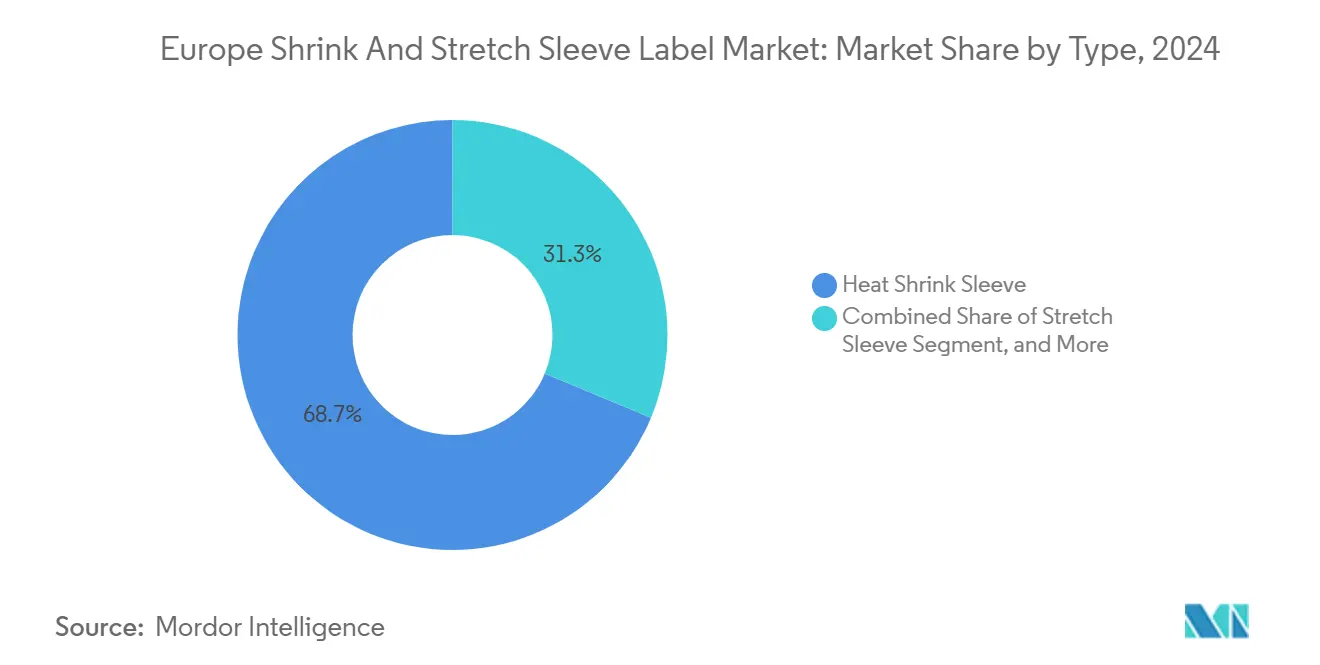
Note: Segment shares of all individual segments available upon report purchase
By Material: PET-G Leadership Challenged by Polyolefin Rise
PET-G still captured 40.23% of the Europe shrink and stretch sleeve label market share in 2024 because of its clarity and stiffness that support high-definition graphics. However, polyolefins enjoy the fastest 5.94% CAGR through 2030 as European recyclers validate float-sink separation that recovers clean PET bottle flake. Brand sustainability scorecards now award bonus points for mono-material decorations, driving procurement shifts. Resin majors have reacted by adding white-grade metallocene polyethylene lines in Belgium and the Netherlands.
Regulators favor polyolefins because they shorten recycling dwell times by 12 minutes per metric ton. Converters investing in surface-energy primers report print-retention parity with PET-G. The Europe shrink and stretch sleeve label market size for polyolefins is set to cross USD 680 million by 2030, narrowing the differential against PET-G. Multilayer PVC applications continue to retreat amid negative consumer perception and tightening REACH restrictions.
By Application: Beverage Pressure Drives Personal Care Growth
Beverage held 45.89% of the Europe shrink and stretch sleeve label market size in 2024, leveraging full-body graphics to mask lightweighting ribs on thin-wall PET bottles. Deposit-return mandates now recalibrate design criteria around barcode readability and easy detachment, pushing fillers toward clear windows or partial sleeves. Personal care emerges as the fastest-growing use case at 5.78% CAGR as brands exploit cylindrical shampoo and lotion bottles for storytelling and premium finishes. Glass-jar skincare launches increasingly specify matte-varnish shrink sleeves to differentiate on crowded shelves.
Food applications remain steady as tamper evidence gains priority for chilled ready-meals. Pharmaceutical uptake benefits from EU Falsified Medicines Directive serialization zones that fit easily on full-body sleeves. As beverage adapts to DRS complexity, converters diversify into nutraceutical powders and household cleaners where sleeve graphics protect against moisture while enabling vibrant color palettes.
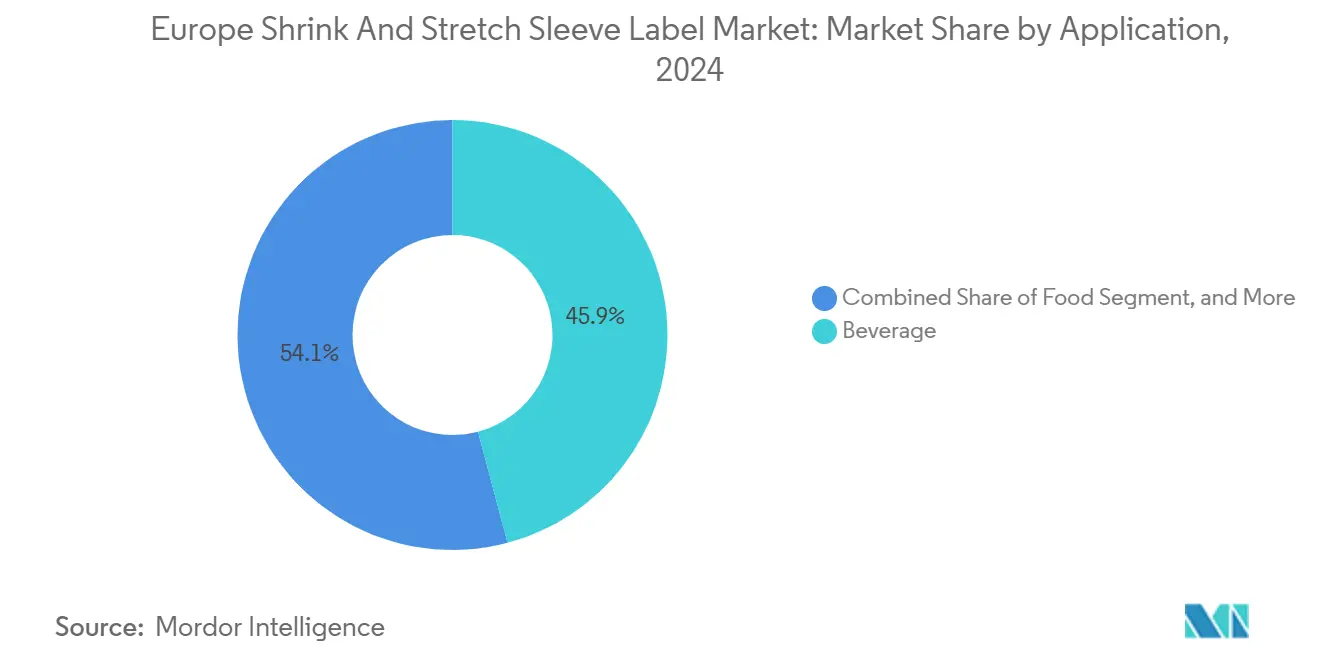
Note: Segment shares of all individual segments available upon report purchase
Geography Analysis
Germany accounts for 25.67% of Europe shrink and stretch sleeve label market consumption in 2024, leveraging a mature DRS network that processes over 17 billion containers annually. Local converters cooperate with PET recyclers to qualify floatable inks, reducing contamination fines imposed by Green Dot compliance schemes. Government R&D grants covering up to 30% of capex accelerate adoption of digital hybrid presses, keeping domestic suppliers competitive despite high labor costs.
Poland records the fastest 6.13% CAGR to 2030, anchored by food-processing output that tops EUR 35 billion and rising export shipments to Western Europe.[3] Food Export Association, “2025 UES Market Assessment - Europe,” foodexport.org Newly established sleeve plants near Łódź benefit from lower wage levels and proximity to flexo-ink manufacturers. EU cohesion funds finance waste-sorting upgrades that support PPWR compliance, encouraging multinationals to site regional packaging hubs in the country.
France, United Kingdom, Italy, and Netherlands hold significant shares as legacy consumer-goods clusters. The United Kingdom’s confirmed October 2027 DRS launch injects near-term volatility as converters frontload design trials. Spanish demand grows on the back of beverage export contracts to Latin America, while Nordic markets command price premiums through eco-labels that certify sleeves’ recyclability. Regulatory convergence gradually erodes cross-border supply barriers, allowing high-volume German and Polish plants to service peripheral markets with competitive lead times.
Competitive Landscape
Market concentration is moderate; the five largest converters collectively control roughly 48% of revenue. Berry Global operates 94 facilities across Europe, giving it scale to localize compliance solutions such as polyolefin perforated sleeves. Avery Dennison leverages its Materials Group to bundle shrink sleeves with pressure-sensitive offerings, improving wallet share among brand owners. Constantia Flexibles expands into stretch sleeves after acquiring a Polish converter in 2024, targeting personal-care accounts.
Raw-material volatility triggers consolidation: three mid-size Italian converters merged in 2025 to secure resin procurement leverage. Digital printing capabilities act as a moat; converters with HP Indigo and Bobst hybrid assets win limited-edition beverage runs at 20% price premiums. Sustainability credentials increasingly influence RFQs, with CELAB-Europe membership now a prerequisite for many FMCG tenders. Technology partnerships around ultra-thin lithium-ink sleeves create differentiation and patents bolster pricing power.
Europe Shrink And Stretch Sleeve Label Industry Leaders
-
CCL Industries Inc.
-
Fuji Seal International Inc.
-
Amcor PLC
-
Klockner Pentaplast GmbH and Co. KG
-
Multi-Color Corporation
- *Disclaimer: Major Players sorted in no particular order
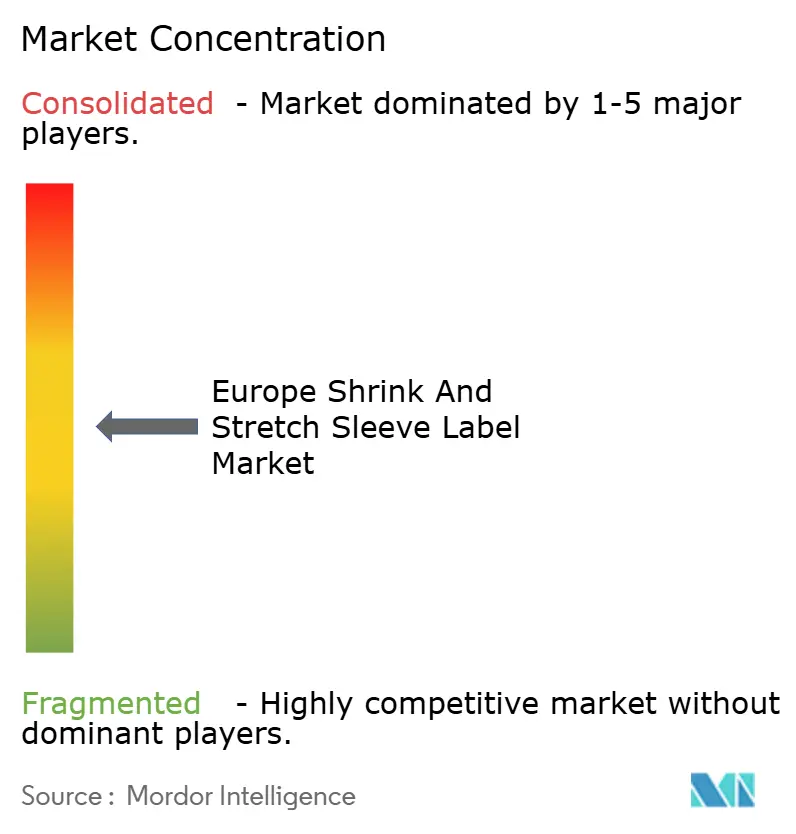
Recent Industry Developments
- February 2025: EU Packaging and Packaging Waste Regulation (PPWR) 2025/40 enters into force mandating recyclability for all packaging by 2030 and setting minimum recycled-content thresholds.
- December 2024: Eurostat confirms plastic-packaging recycling rate reached 41% in 2022.
- October 2024: UK Government confirms deposit-return scheme go-live by Oct 2027 for England and Northern Ireland.
- September 2024: Avery Dennison states shrink sleeves represent about 20% of the USD 11 billion pressure-sensitive label sector during investor day.
Europe Shrink And Stretch Sleeve Label Market Report Scope
Stretch and shrink sleeve labels are polyester or plastic labels that wrap the entire perimeter of a product and conform to the unique geometry of any package. The market study comprises an analysis by type, material, and application. The study also covers various major European countries.
The impact of the COVID-19 pandemic on the key customer sectors and the nature of the product delivery are also provided, and this assessment is done by considering a wide range of regional factors.
| Heat Shrink Sleeve |
| Stretch Sleeve |
| Other Types |
| Polyvinyl Chloride (PVC) |
| Polyethylene Terephthalate Glycol-modified (PET-G) |
| Polyethylene (PE) |
| Polypropylene (PP) |
| Other Materials |
| Beverage |
| Food |
| Personal Care |
| Other Applications |
| Germany |
| France |
| United Kingdom |
| Italy |
| Russia |
| Poland |
| Netherlands |
| Spain |
| Rest of Europe |
| By Type | Heat Shrink Sleeve |
| Stretch Sleeve | |
| Other Types | |
| By Material | Polyvinyl Chloride (PVC) |
| Polyethylene Terephthalate Glycol-modified (PET-G) | |
| Polyethylene (PE) | |
| Polypropylene (PP) | |
| Other Materials | |
| By Application | Beverage |
| Food | |
| Personal Care | |
| Other Applications | |
| By Country | Germany |
| France | |
| United Kingdom | |
| Italy | |
| Russia | |
| Poland | |
| Netherlands | |
| Spain | |
| Rest of Europe |
Key Questions Answered in the Report
What is the current value of Europes shrink and stretch sleeve label space?
In 2025 the region records USD 1.77 billion in shrink and stretch sleeve label sales, heading toward USD 2.23 billion by 2030 at a 4.73% CAGR.
Which sleeve type is gaining fastest in Europe?
Stretch sleeves are growing at a 5.89% CAGR through 2030 as brands favor easy removal for deposit-return compliance.
How large is Germanys share of regional sleeve demand?
Germany accounts for 25.67% of European consumption thanks to its mature recycling network and early DRS experience.
Which end-use segment shows the most momentum?
Personal care packaging leads growth with a 5.78% CAGR, driven by premium positioning and 360-degree branding.
Why are polyolefin sleeves attracting investment?
Mono-material polyethylene floats during PET recycling, meeting PPWR recyclability targets and supporting converters sustainability pledges.
How concentrated is the competitive landscape?
The five biggest converters hold roughly 48% of revenue, giving the sector a moderate concentration score of 6.
Page last updated on:
